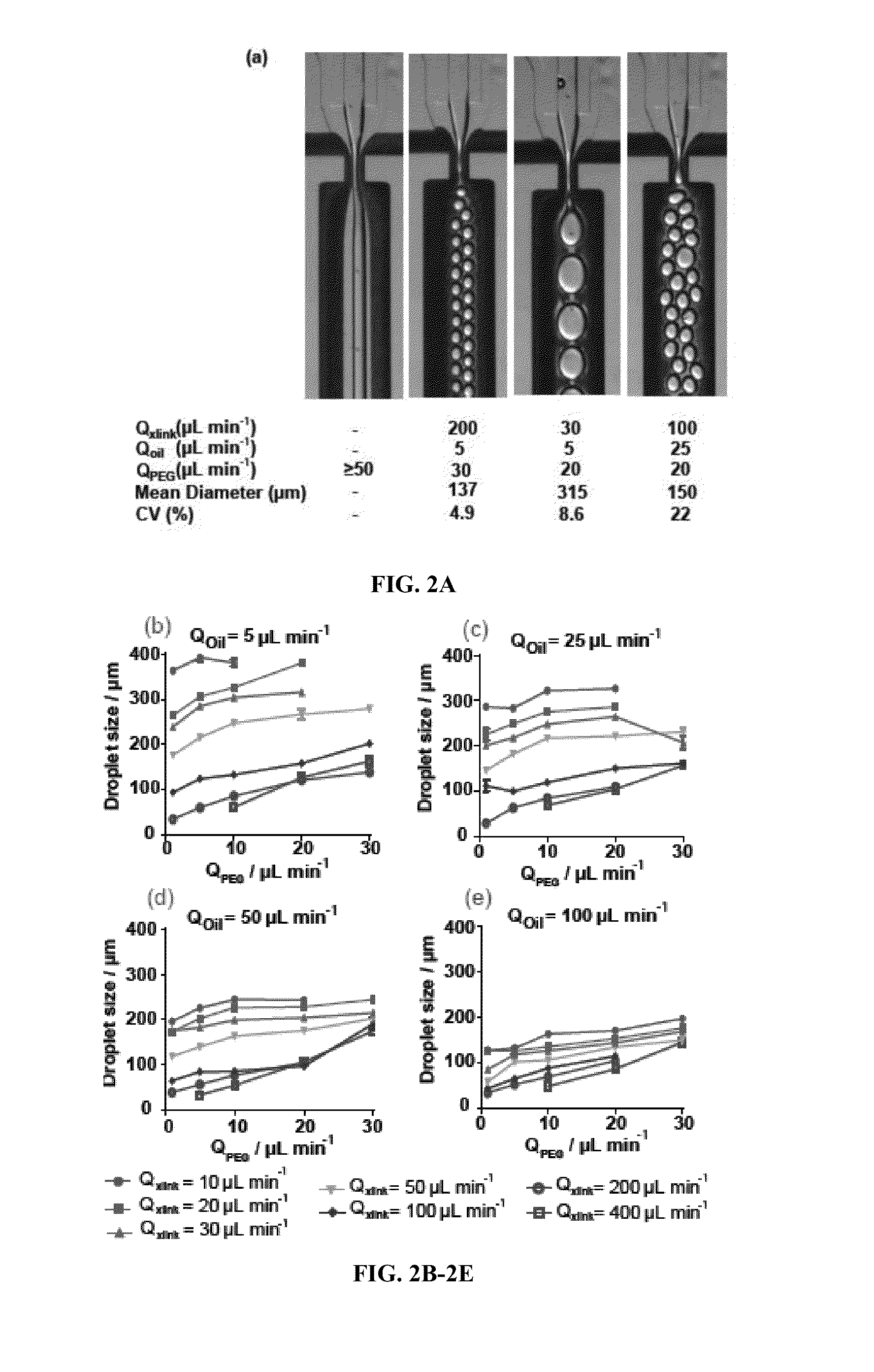Microgels for Encapsulation of Cells and Other Biologic Agents
a bioactive agent and microgel technology, applied in the field of microgels for encapsulation of cells and other biologic agents, can solve the problems of limited control of local cellular environment via incorporation of bioactive molecules (e.g., adhesive peptides), significant complexity of microfluidic devices, and translation of this work into covalent crosslinking of microgels within microfluidics, etc., to achieve the effect of enhancing cell adhesion and survival
- Summary
- Abstract
- Description
- Claims
- Application Information
AI Technical Summary
Benefits of technology
Problems solved by technology
Method used
Image
Examples
example 1
Design and Testing of a Microfluidic Strategy for Encapsulating Cells and other Biological Agents
Materials and Methods
[0121]Microfluidic Device Preparation
[0122]PDMS microfluidic flow focusing devices were cast using soft lithography from silicon and SU8 masters that were fabricated by the Stanford Microfluidics Foundry. Devices with 300 μm nozzles were bonded directly to glass slides after treatment with air plasma. 600 μm nozzle devices were manufactured by first bonding mirror-image PDMS channels, each with 300 μm depth, together to create a channel with 600 μm depth.
[0123]PEG-4MAL Microgel Formation and Particle Encapsulation
[0124]Flow-focusing microfluidic geometry was utilized to form polymer droplets. Both shielding and crosslinker phases consisted of light mineral oil (Sigma) with 2% SPAN80 (Sigma). The crosslinker phase also contained an emulsion, at a ratio of 1:15, of 20 mg / mL dithiothreitol (DTT) (Sigma) in PBS. A co-flowing shielding phase protected the macromer solutio...
example 2
Size and Dispersity of the Microgels are Tunable Materials and Methods
[0127]Microgel Size Control
[0128]To characterize the relationship between microgel size and the various macromer solution and continuous phase flow rates, hydrogel droplets were generated using computer-controlled syringe pumps, and were measured while still in the microfluidic chip. Harvard Apparatus Elite syringe pumps were computer controlled using FlowControl software to pump inlet solutions at various flow rates. Video was recorded during droplet generation using a Hammamatsu ORCA-ERA 1394 camera connected to a Nikon TE300 microscope. Droplet diameter was measured using ImageJ analysis software. The coefficient of variation (CV) was calculated for each flow rate combination by dividing the standard deviation of the sample by its mean. At least 30 microgels were measured for each flow rate combination.
Results
[0129]Precise control of particle size and monodispersity are critical for many applications of microge...
example 3
Permeability of the Microgels is Tunable
Materials and Methods
[0131]Protein Encapsulation and Release
[0132]AlexaFluor488-labeled IgG (goat anti-rabbit IgG, Life Technologies), bovine serum albumin-AlexaFluor488 conjugate (Life Technologies), 2-NBDglucose (Life Technologies) or insulin (Sigma) tagged with AlexaFluor488 was dissolved in a 5% PEG-4MAL (10 kDa or 20 kDa) solution before being microencapsulated by macromere droplet gelation. To prevent proteins from being crosslinked by the macromer, thiols were capped using aminoethylate reagent (Thermo Scientific) according to product instructions. Particles were washed and resuspended in PBS and divided into 5 replicates containing 2 mL total volume. 50 μL samples were taken of supernatant alone, as well as of supernatant containing well-mixed, protein-laden microgels. These samples were placed in a 96 well plate, and their fluorescent intensity was measured using a Perkin Elmer HTS 7000 plate reader. To generate release curves, supern...
PUM
| Property | Measurement | Unit |
|---|---|---|
| size | aaaaa | aaaaa |
| size | aaaaa | aaaaa |
| size | aaaaa | aaaaa |
Abstract
Description
Claims
Application Information
 Login to View More
Login to View More - R&D
- Intellectual Property
- Life Sciences
- Materials
- Tech Scout
- Unparalleled Data Quality
- Higher Quality Content
- 60% Fewer Hallucinations
Browse by: Latest US Patents, China's latest patents, Technical Efficacy Thesaurus, Application Domain, Technology Topic, Popular Technical Reports.
© 2025 PatSnap. All rights reserved.Legal|Privacy policy|Modern Slavery Act Transparency Statement|Sitemap|About US| Contact US: help@patsnap.com



